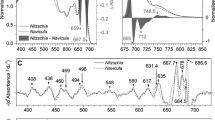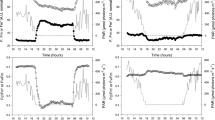Abstract
The intertidal brown alga Silvetia compressa releases gametes from receptacles (the reproductive tissue) rapidly upon a dark transfer (following a photosynthesis-dependent period in the light, termed potentiation). In this study, the wavelength-dependence of this process was investigated. During the potentiation period in white light (WL), gametes are not released. However, gametes were released during potentiation in blue light (BL), or in low red light/blue light (RL/BL) ratios, but not in RL alone, high RL/BL ratios, or in broadband blue-green light (B-GL) (presence of BL, but absence of RL). RL was as effective as WL for potentiation, i.e., both lead to gamete release following transfer to darkness. Rates of linear photosynthetic electron transport were similar in RL and BL. Gamete release in BL was inhibited by equal amounts of additional narrow-waveband light between the green and red regions of the spectrum, with light-induced gamete release restricted between <491 nm and 509 nm. Very little light-induced gamete release occurred between 530 nm and 650 nm. It is proposed that a BL-responsive photoreceptor is responsible for light-induced gamete release. Transfer of WL-potentiated receptacles to GL near 530 nm resulted in significant de-potentiation and reduced gamete release during a subsequent dark transfer. This effect was not seen at 509 nm or 560 nm and revealed the presence of a second photoreceptor system repressing or counteracting potentiation in the light. We propose that the restriction of gamete release to periods when irradiance is blue-shifted may constitute a depth-sensing mechanism for this intertidal alga, allowing controlled release of gametes at high tide and/or less turbid periods, thus minimizing gamete dilution, and promoting fertilization success.







Similar content being viewed by others
References
Assmann SM (1993) Signal transduction in guard cells. Annu Rev Cell Biol 9:345–375
Babcock RC, Bull GD, Harrison PL, Heyward AJ, Oliver JK, Wallace CC, Willis BL (1986) Synchronous spawning of 105 scleractinian coral species on the Great Barrier Reef. Mar Biol 90:379–394
Bamberg E, Tittor J, Oesterhelt D (1993) Light-driven proton or chloride pumping by halorhodopsin. Proc Natl Acad Sci USA 90:639–643
Berndt M-L, Callow JA, Brawley SH (2002) Gamete concentrations and timing and success of fertilization in a rocky shore seaweed. Mar Ecol Prog Ser 226:273–285
Brawley SH (1992) Fertilization in natural populations of the dioecious brown alga Fucus ceranoides and the importance of the polyspermy block. Mar Biol 113:145–157
Brawley SH, Johnson LE, Pearson GA, Speransky V, Li R, Serrão E (1999) Gamete release at low tide in fucoid algae: maladaptive or advantageous? Am Zool 39:218–229
Cho MH, Spalding EP (1996) An anion channel in Arabidopsis hypocotyls activated by blue light. Proc Natl Acad Sci USA 93:8134–8138
Clifton KE (1997) Mass spawning by green algae on coral reefs. Science 275:1116–1118
Denny MW, Shibata MF (1989) Consequences of surf-zone turbulence for settlement and external fertilization. Am Nat 134:859–889
Dring MJ (1989) Stimulation of light-saturated photosynthesis in Laminaria (Phaeophyta) by blue light. J Phycol 25:254–257
Dring MJ, Lüning K (1975) A photoperiodic response mediated by blue-light in the brown alga Scytosiphon lomentaria. Planta 125:25–32
Eckert M, Kaldenhoff R (2000) Light-induced stomatal movement of selected Arabidopsis thaliana mutants. J Exp Bot 51:1435–1442
Forster RM, Dring MJ (1992) Interactions of blue light and inorganic carbon supply in the control of light-saturated photosynthesis in brown algae. Plant Cell Environ 15:241–247
Frechilla S, Zhu J, Talbott LD, Zeiger E (1999) Stomata from npq1, a zeaxanthin-less Arabidopsis mutant, lack a specific response to blue light. Plant Cell Physiol 40:949–954
Frechilla S, Talbott LD, Bogomolni RA, Zeiger E (2000) Reversal of blue light-stimulated stomatal opening by green light. Plant Cell Physiol 41:171–176
Genty B, Briantais JM, Baker NR (1989) The relationship between the quantum yield of photosynthetic electron transport and quenching of chlorophyll fluorescence. Biochim Biophys Acta 990:87–92
Harrison PL, Babcock RC, Bull GD, Oliver JK, Wallace CC, Willis BL (1984) Mass spawning in tropical reef corals. Science 223:1186–1189
Haupt W (1983) Movements of chloroplasts under the control of light. Prog Phycol Res 2:227–281
Hedrich R, Marten I (1993) Malate-induced feedback regulation of plasma membrane anion channels could provide a CO2 sensor to guard cells. EMBO J 12:897–901
Hedrich R, Marten I, Lohse G, Dietrich P, Winter H, Lohaus G, Heldt H-W (1994) Malate-sensitive anion channels enable guard cells to sense changes in the ambient CO2 concentration. Plant J 6:741–748
Hedrich R, Neimanis S, Savchenko G, Felle HH, Kaiser WM, Heber U (2001) Changes in apoplastic pH and membrane potential in leaves in relation to stomatal responses to CO2, malate, abscisic acid or interruption of water supply. Planta 213:594–601
Jaffe LF (1954) Stimulation of the discharge of gametangia from a brown alga by a change from light to darkness. Nature 174:743
Johnson LE, Brawley SH (1998) Dispersal and recruitment in a canopy-forming intertidal alga, Pelvetia compressa (Phaeophyceae). Oecologia 117:517–526
Kinoshita T, Doi M, Suetsugu N, Kawaga T, Shimazaki KI (2001) Phot1 and phot2 mediate blue light regulation of stomatal opening. Nature 414:656–660
Kropf DL (1992) Establishment and expression of cellular polarity in fucoid zygotes. Microbiol Rev 56:316–339
Levitan DR, Petersen C (1995) Sperm limitation in the sea. Trends Ecol Evol 10:228–231
Morgan SG (1995) The timing of larval release. In: McEdward L (ed) Ecology of marine invertebrate larvae. CRC, Boca Raton, pp 157–191
Nuccitelli R, Jaffe LF (1975) The pulse current pattern generated by developing fucoid eggs. J Cell Biol 64:636–643
Nuccitelli R, Jaffe LF (1976) Current pulses involving chloride and potassium efflux relieve excess pressure in Pelvetia embryos. Planta 131:315–320
Nultsch W (1984) Circadian rhythms in chromatophore movements of Dictyota dichotoma. Mar Biol 81:217–222
Pearson GA, Brawley SH (1996) Reproductive ecology of Fucus distichus (Phaeophyceae): an intertidal alga with successful external fertilization. Mar Ecol Prog Ser 143:211–223
Pearson GA, Brawley SH (1998) A model for signal transduction during gamete release in the fucoid alga Pelvetia compressa. Plant Physiol 118:305–313
Pearson GA, Serrão EA, Brawley SH (1998) Control of gamete release in fucoid algae: sensing hydrodynamic conditions via carbon acquisition. Ecology 79:1725–1739
Robinson KR, Miller BJ (1997) The coupling of cyclic GMP and photopolarization of Pelvetia zygotes. Dev Biol 187:125–130
Robinson KR, Lorenzi R, Ceccarelli N, Gualtieri P (1998) Retinal identification in Pelvetia fastigiata. Biochem Biophys Res Commun 243:776–778
Robinson KR, Wozniak M, Pu R, Messerli M (1999) Symmetry breaking in the zygotes of the fucoid algae: controversies and recent progress. Curr Topic Dev Biol 44:101–125
Schmid R, Dring MJ (1992) Circadian rhythm and fast responses to blue light of photosynthesis in Ectocarpus (Phaeophyta, Ectocarpales). I. Characterization of the rhythm and the blue-light response. Planta 187:53–59
Schmid R, Dring MJ (1993) Rapid, blue-light-induced acidifications at the surface of Ectocarpus and other marine macroalgae. Plant Physiol 101:907–913
Schmid R, Dring MJ (1996) Blue light and carbon acquisition in brown algae: an overview and recent developments. Sci Mar 60 [Suppl. 1]:115–124
Schmid R, Dring MJ, Forster RM (1994) Kinetics of blue-light stimulation and circadian rhythmicity of light-saturated photosynthesis in brown algae: a species comparison. J Phycol 30:612–621
Schwartz A, Ilan N, Schwarz M, Scheaffer J, Assmann SM, Schroeder JI (1995) Anion-channel blockers inhibit S-type anion channels and abscisic acid responses in guard cells. Plant Physiol 109:651–658
Serrão EA, Pearson GA, Kautsky L, Brawley SH (1996) Successful external fertilization in turbulent environments. Proc Natl Acad Sci USA 93:5286–5290
Serrão EA, Alice LA, Brawley SH (1999) Evolution of the Fucaceae (Phaeophyceae) inferred from nrDNA-ITS. J Phycol 35:382–394
Speransky VV, Brawley SH, McCully ME (2001) Ion fluxes and modification of the extracellular matrix during gamete release in fucoid algae. J Phycol 37:555–573
Togashi T, Cox PA (2001) Tidal-linked synchrony of gamete release in the marine green alga, Monostroma angicava Kjellman. J Exp Mar Biol Ecol 264:117–131
Yoshioka E (1988) Spawning periodicities coinciding with semidiurnal tidal rhythms in the chiton Acanthopleura japonica. Mar Biol 98:381–385
Yund PO (2000) How severe is sperm limitation in natural populations of marine free-spawners? Trends Ecol Evol 15:10–13
Zeiger E, Zhu J (1998) Role of zeaxanthin in blue light photoreception and the modulation of light-CO2 interactions in guard cells. J Exp Bot 49:433–442
Acknowledgements
G.P., E.S., and M.D. express our gratitude to Professor Paul Galland for hosting our visits to his laboratory in Marburg, his generosity in allowing us access to equipment, as well as helpful discussions. Many and ever-reliable algal collections were made by Diana Steller, University of California at Santa Cruz, Calif., USA. Silvia Busch (Philipps-Universitaet, Marburg, Germany) provided fine selections of bread for breakfast. Funding by the COST-49 program (EU), the Portuguese Science Foundation (FCT) project GAMETE (POCTI/BSE/39431/2001), and an FCT and European Social Fund (FSE) fellowship to G.P.
Author information
Authors and Affiliations
Corresponding author
Rights and permissions
About this article
Cite this article
Pearson, G.A., Serrão, E.A., Dring, M. et al. Blue- and green-light signals for gamete release in the brown alga, Silvetia compressa . Oecologia 138, 193–201 (2004). https://doi.org/10.1007/s00442-003-1424-z
Received:
Accepted:
Published:
Issue Date:
DOI: https://doi.org/10.1007/s00442-003-1424-z




